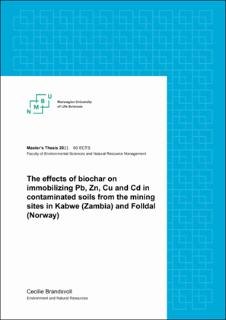| dc.description.abstract | Mining activities and resulting waste products are among the main sources of severe heavy metal pollution in the world. This study aims to examine i) the level of soil contamination, ii) mobility and ii) bioavailability of Pb, Zn, Cu and Cd in two mine-influenced areas in Kabwe in Zambia, and Folldal in Norway. Secondly, this study aims to discover the effects of pigeon pea biochar (pyrolyzed at 600 C) on immobilizing these metals. The methods used were i) Total soil metal contents though total digestion and elemental analysis, using international threshold guidelines to determine level of contamination. ii) Equilibrium batch-titration experiment with metal speciation of equilibrium solution using WHAM VII, and iii) Diffusive gradients in thin films (DGT) to determine bioavailability. The two latter experiments were done in parallel with and without the treatment of biochar. The main findings showed that the adjacent areas to the mine (15–1580m) in Kabwe is severely polluted by Pb and Zn, and excessive levels of Cu were detected in the mine tailings in Folldal. The biochar treatment significantly (p<0.05) reduced the bioavailable metal levels in the most polluted sample in Kabwe by 64 8%, 68 3%, 29 17% and 63 3% for Pb, Zn, Cu and Cd, respectively, with similar effects detected for metal mobility. The Folldal samples showed diverse effects to the biochar treatment, with significantly reduced mobility of Cu by 92 1% and 13 1% detected for two different samples. The metal immobilization properties of biochar were mainly assigned to the biochar-induced increase in pH causing hydrolysis of the free metal ions and precipitation of hydroxides or carbonates, but significant (p<0.05) sorption also occurred. However, using biochar with higher CEC would likely increase the observed effects. The study further highlights the importance of investigating mobility and/or bioavailability of metals, as the total metal concentration alone failed to describe the true environmental risks associated with the mine tailings in Folldal. | en_US |

